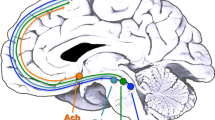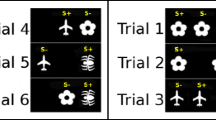Abstract
The prefrontal cortex is implicated in cognitive functioning and schizophrenia. Prefrontal dysfunction is closely associated with the symptoms of schizophrenia. In addition to the features typical of schizophrenia, patients also present with aspects of cognitive disorders. Based on these relationships, a monkey model mimicking the cognitive symptoms of schizophrenia has been made using treatment with the non-specific competitive N-methyl-D-aspartate receptor antagonist, phencyclidine. The symptoms are ameliorated by atypical antipsychotic drugs such as clozapine. The beneficial effects of clozapine on behavioral impairment might be a specific indicator of schizophrenia-related cognitive impairment.
Similar content being viewed by others
References
Insel T. Rethinking schizophrenia. Nature 2010, 468: 187–193.
Akdeniz C1, Tost H, Meyer-Lindenberg A. The neurobiology of social environmental risk for schizophrenia: an evolving research field. Soc Psychiatry Psychiatr Epidemiol 2014, 49: 507–517.
Schmitt A, Malchow B, Hasan A, Falkai P. The impact of environmental factors in severe psychiatric disorders. Front Neurosci 2014, 8: 19.
Bergen SE, O’Dushlaine CT, Lee PH, Fanous AH, Ruderfer DM, Ripke S, et al. Genetic modifiers and subtypes in schizophrenia: Investigations of age at onset, severity, sex and family history. Schizophr Res 2014, 154: 48–53.
Fuster JM. Frontal lobes. Curr Opin Neurobiol 1993, 3: 160–165.
Fuster Joaquin M. The prefrontal cortex. Los Angeles, CA: Academic Press, 2008.
Goldman-Rakic PS. Topography of cognition: parallel distributed networks in primate association cortex. Annu Rev Neurosci 1988, 11: 137–156.
Neubert FX, Mars RB, Thomas AG, Sallet J, Rushworth MF. Comparison of human ventral frontal cortex areas for cognitive control and language with areas in monkey frontal cortex. Neuron 2014, 81: 700–713.
Weinberger DR, Berman KF, Zec RF. Physiologic dysfunction of dorsolateral prefrontal cortex in schizophrenia. I. Regional cerebral blood flow evidence. Arch Gen Psychiatry 1986, 43: 114–124.
Andreasen N, Nasrallah HA, Dunn V, Olson SC, Grove WM, Ehrhardt JC, et al. Structural abnormalities in the frontal system of schizophrenia. Arch Gen Psychiatry 1986, 43: 136–144.
Andreasen NC, Flashman L, Flaum M, Arndt S, Swayze V 2nd, O’Leary DS, et al. Regional brain abnormalities in schizophrenia measured with magnetic resonance imaging. JAMA 1994, 272: 1763–1769.
Harvey I, Ron MA, Du Boulay G, Wicks D, Lewis SW, Murray RM. Reduction of cortical volume in schizophrenia on magnetic resonance imaging. Psychol Med 1993, 23: 591–604.
Nopoulos PC, Flaum M, Andreasen NC, Swayze VW. Gray matter heterotopias in schizophrenia. Psychiatry Res 1995, 61: 11–14.
Goldman-Rakic PS, Selemon LD. Functional and anatomical aspects of prefrontal pathology in schizophrenia. Schizophr Bull 1997, 23: 437–58.
Park S, Holzman PS, Goldman-Rakic PS. Spatial working memory deficits in the relatives of schizophrenic patients. Arch Gen Psychiatry 1995, 52: 821–828.
Park S, Holzman PS, Goldman-Rakic PS. Abnormally high neuronal density in the schizophrenic cortex. A morphometric analysis of prefrontal area 9 and occipital area 17. Arch Gen Psychiatry 1995, 52: 805–818.
Radley JJ, Rocher AB, Janssen WG, Hof PR, McEwen BS, Morrison JH. Reversibility of apical dendritic retraction in the rat medial prefrontal cortex following repeated stress. Exp Neurol 2005, 196: 199–203.
Radley JJ, Rocher AB, Miller M, Janssen WG, Liston C, Hof PR, et al. Repeated stress induces dendritic spine loss in the rat medial prefrontal cortex. Cereb Cortex 2006, 16: 313–320.
Glantz LA, Austin MC, Lewis DA. Normal cellular levels of synaptophysin mRNA expression in the prefrontal cortex of subjects with schizophrenia. Biol Psychiatry 2000, 48: 389–397.
Coyle JT, Tsai G. The NMDA receptor glycine modulatory site: a therapeutic target for improving cognition and reducing negative symptoms in schizophrenia. Psychopharmacology (Berl). 2004, 174: 32–38.
Finlay JM. Mesoprefrontal dopamine neurons and schizophrenia: role of developmental abnormalities. Schizophrenia Bull 2001, 27: 431–442.
Robbins TW, Arnsten AF. The neuropsychopharmacology of fronto-executive function: monoaminergic modulation. Annu Rev Neurosci 2009, 32: 267–287.
Arnsten AF. Stress impairs prefrontal cortical function in rats and monkeys: role of dopamine D1 and norepinephrine alpha-1 receptor mechanisms. Prog Brain Res 2000, 126: 183–192.
Wang M, Ji JZ, Li BM. The alpha(2A)-adrenergic agonist guanfacine improves visuomotor associative learning in monkeys, Neuropsychopharmacology 2004, 29: 86–92.
Arnsten AF, Li BM. Neurobiology of executive functions: catecholamine influences on prefrontal cortical functions. Biol Psychiatry 2005, 57: 1377–1384.
Orellana G, Slachevsky A. Executive functioning in schizophrenia. Front Psychiatry 2013, 4: 35.
Goghari VM, Macdonald AW 3rd, Sponheim SR. Relationship between prefrontal gray matter volumes and working memory performance in schizophrenia: A family study. Schizophr Res 2014, 153: 113–121.
Wheeler AL, Chakravarty MM, Lerch JP, Pipitone J, Daskalakis ZJ, Rajji TK, et al. Disrupted prefrontal interhemispheric structural coupling in schizophrenia related to working memory performance. Schizophr Bull 2014, 40: 914–924.
van Kammen DP, van Kammen WB, Mann LS, Seppala T, Linnoila M. Dopamine metabolism in the cerebrospinal fluid of drug-free schizophrenic patients with and without cortical atrophy. Arch Gen Psychiatry 1986, 43: 978–983.
Weinberger DR. Schizophrenia and the frontal lobe. Trends Neurosci 1988, 11: 367–370.
Heritch AJ. Evidence for reduced and dysregulated turnover of dopamine in schizophrenia. Schizophrenia Bull 1990, 16: 605–615.
Okubo Y, Suhara T, Suzuki K, Kobayashi K, Inoue O, Terasaki O, et al. Decreased prefrontal dopamine D1 receptors in schizophrenia revealed by PET. Nature 1997, 385: 634–636.
Jentsch JD, Redmond DE Jr, Elsworth JD, Taylor JR, Youngren KD, Roth RH. Enduring cognitive deficits and cortical dopamine dysfunction in monkeys after long-term administration of phencyclidine. Science 1997, 277: 953–955.
Giannini AJ, Underwood NA, Condon M. Acute ketamine intoxication treated by haloperidol: a preliminary study. Am J Ther 2000, 7: 389–391.
Liang HJ, Lau CG, Tang A, Chan F, Ungvari GS, Tang WK. Cognitive impairments in poly-drug ketamine users. Addict Behav 2013, 38: 2661–2666.
Tang WK, Liang HJ, Lau CG, Tang A, Ungvari GS. Relationship between cognitive impairment and depressive symptoms in current ketamine users. J Stud Alcohol Drugs 2013, 74: 460–468.
John D. Current MD. Pharmacology for Anesthetists. Mainz, Germany: PediaPress, 2011.
Bergman SA. Ketamine: review of its pharmacology and its use in pediatric anesthesia. Anesth Prog 1999, 46: 10–20.
Giannini AJ, Loiselle RH, Giannini MC, Price WA. Phencyclidine and the dissociatives. Psychiatr Med 1985, 3: 197–217.
Grayson B, Adamson L, Harte M, Leger M, Marsh S, Piercy C, et al. The involvement of distraction in memory deficits induced by NMDAR antagonism: Relevance to cognitive deficits in schizophrenia. Behav Brain Res 2014, pii: S0166–432800157-0.
Jodo E. The role of the hippocampo-prefrontal cortex system in phencyclidine-induced psychosis: a model for schizophrenia. J Physiol Paris 2013, 107: 434–440.
Zhang R, He J, Zhu S, Zhang H, Wang H, Adilijiang A, et al. Myelination deficit in a phencyclidine-induced neuro-developmental model of schizophrenia. Brain Res 2012, 1469: 136–143.
McKim WA, Hancock S. Drugs and Behavior. Cambridge: Pearson Publisher, 2013.
Eddins D, Hamill TG, Puri V, Cannon CE, Vivian JA, Sanabria-Bohórquez SM, et al. The relationship between glycine transporter 1 occupancy and the effects of the glycine transporter 1 inhibitor RG1678 or ORG25935 on object retrieval performance in scopolamine impaired rhesus monkey. Psychopharmacology (Berl). 2014, 231: 511–519.
Gray RA, Wilcox KM, Zink MC, Weed MR. Impaired performance on the object retrieval-detour test of executive function in the SIV/macaque model of AIDS. AIDS Res Hum Retroviruses 2006, 22: 1031–5.
Jentsch JD, Roth RH, Taylor JR. Object retrieval/detour deficits in monkeys produced by prior subchronic phencyclidine administration: evidence for cognitive impulsivity. Biol Psychiatry 2000, 48: 415–424.
Taylor JR, Roth RH, Sladek JR Jr, Redmond DE Jr. Cognitive and motor deficits in the performance of an object retrieval task with a barrier-detour in monkeys (Cercopithecus aethiops sabaeus) treated with MPTP: long-term performance and effect of transparency of the barrier. Behav Neurosci 1990, 104: 564–576.
Taylor JR, Elsworth JD, Roth RH, Sladek JR Jr, Redmond DE Jr. Cognitive and motor deficits in the acquisition of an object retrieval/detour task in MPTP-treated monkeys. Brain 1990, 113(Pt 3): 617–637.
Simen AA, DiLeone R, Arnsten AF. Primate models of schizophrenia: future possibilities, Prog Brain Res 2009, 179: 117–125.
Funahashi S, Bruce CJ, Goldman-Rakic PS. Dorsolateral prefrontal lesions and oculomotor delayed-response performance: evidence for mnemonic “scotomas”. J Neurosci 1993, 13: 1479–1497.
Jones CA, Watson DJ, Fone KC. Animal models of schizophrenia. Br J Pharmacol 2011, 164: 1162–1194.
Wilson C, Terry AV Jr. Neurodevelopmental animal models of schizophrenia: role in novel drug discovery and development. Clin Schizophr Relat Psychoses 2010, 4: 124–37.
Niu Y, Yu Y, Bernat A, Yang S, He X, Guo X, et al. Transgenic rhesus monkeys produced by gene transfer into early-cleavage-stage embryos using a simian immunodeficiency virus-based vector. Proc Natl Acad Sci U S A 2010, 107: 17663–17667.
Niu Y, Shen B, Cui Y, Chen Y, Wang J, Wang L, et al. Generation of gene-modified cynomolgus monkey via Cas9/RNA-mediated gene targeting in one-cell embryos. Cell 2014, 156: 836–843.
Yang LC, Li MH, Wilson FA, Hu XT, Ma YY. Prefrontal attention and multiple reference frames during working memory in primates. Chin Sci Bull 2013, 58: 449–455.
Author information
Authors and Affiliations
Corresponding author
Rights and permissions
About this article
Cite this article
Mao, P., Cui, D., Zhao, XD. et al. Prefrontal dysfunction and a monkey model of schizophrenia. Neurosci. Bull. 31, 235–241 (2015). https://doi.org/10.1007/s12264-014-1506-4
Received:
Accepted:
Published:
Issue Date:
DOI: https://doi.org/10.1007/s12264-014-1506-4




